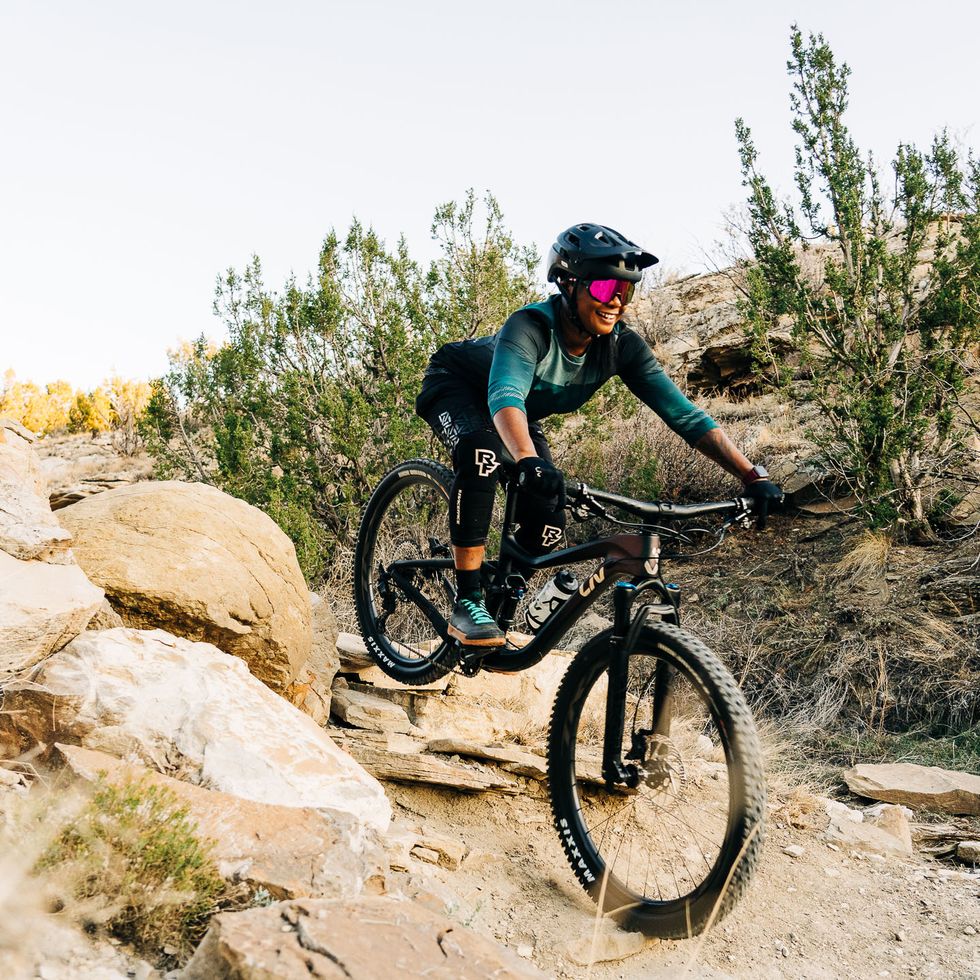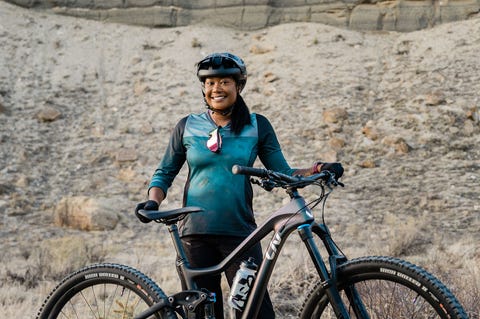
Don’t let anything hold you back from hitting the trails, says the Black Foxes Cofounder, Shanika “Nikki” Rhodes.
Bicycling | March 2022
Read the full story at bicycling.com.
When Shanika “Nikki” Rhodes moved west to Colorado Springs, Colorado, from her home state of Alabama, in 2014, she’d never ridden a mountain bike. Until that point, she actually avoided much physical activity at all, because she had asthma. But in Colorado, on their first date, her boyfriend invited her on a 7-mile out-and-back ride in North Cheyenne Cañon with a gradual climb. Not only was this her first-ever mountain bike ride, but it was also at a higher elevation than Alabama.
Before the ride, “I mentioned to him that I had asthma, so I wasn’t sure how I would perform. He didn’t understand how severe my asthma was. There were several long breaks and many frequent breaks. But he was very patient. Thankfully, the views were amazing,” Rhodes says.
Since that first ride with her boyfriend in 2016, Rhodes has become a local ride guide for the Women’s Mountain Biking Association of Colorado Springs. This year, she will colaunch bike-POC rides for women of color, in addition to group bike rides for all female riders, alongside ride guide and PMBIA Level 1 instructor Natalia Pulido.
Over the years, Rhodes has overcome huge obstacles from health management to frustration and embarrassment to negative perceptions in order to pursue her love of riding a mountain bike.
But those struggles only led to triumphs. The negative perceptions, for example, are one of the reasons Rhodes cofounded the global organization The Black Foxes. As she battled online trolls, she stayed laser-focused on a positive outcome: stopping discriminatory stereotypes about who belongs on a bike.
“Seeing negative comments like, ‘Stop trying to achieve white people things and find your own things to do,’ makes me upset. Who said mountain biking is for white people only? Reading that encouraged me to push harder to be out there creating a BIPOC community that rides and enjoys the outdoors,” says Rhodes.
Launched by eight passionate riders and people of color around the world, including Ayesha McGowan, the first Black American woman to become a professional cyclist, The Black Foxes connect with their followers via social media to push forward a manifesto, which is a compiled list of each founder’s individual mission.
“To me, our mission is to invite and create inclusive space in our industry for Black cyclists and outdoors people to be seen, heard, to share our stories, and to provide representation,” says Rhodes.
Rhodes continues to welcome cyclists to the trails through the organizations she represents. And here, she shares her fine-tuned tips for those who haven’t hopped on a mountain bike yet. Whether it’s asthma, another health limitation, or underrepresentation holding you back, let her advice give you confidence to head outside.
Make a Treatment Plan

Courtesy of Liv Cycling/Evan Green
Figuring out how to control your asthma is paramount, says Rhodes, “I was frustrated and in denial, which pushed me to see an asthma specialist for my first allergy test—I’m allergic to everything outside. Having asthma and mountain biking in a space where I’m allergic, I can understand why I was triggered. My doctors came up with an action plan for me, and that gave me hope that I could control my asthma and still enjoy the sport I love.”
While Rhodes was prescribed allergy medication and an inhaler, of which she takes two puffs 15 to 30 minutes before a ride, she says each individual needs a personalized treatment plan. Talk with your doctors to figure out what will work for you so you can still get outside and hit the trails. That’s step one.
Don’t Ride Solo
“For rides, I always prefer to have someone with me for safety due to my asthma and the wildlife,” Rhodes says. “Having a ride partner also calms my anxiety about being alone with asthma, which can itself become a trigger.”
To find local group rides or new cycling buddies, search for mountain bike groups in your community on social media or online. Local bike shops will also often post about group rides on their social media, says Rhodes. “We have a local page on Facebook called, ‘Colorado Springs Mountain Biking,’ where you can ask others to join you for group rides or talk about the trail conditions,” she says, which has helped her grow her ride network.
Rhodes also aims to ride popular trails, so that she’s never isolated and if she ever does need to pedal alone, she will be surrounded by people. She searches online for mountain bike trails in her location and then reads the reviews and description of the trail to get an idea of how remote or trafficked the route is. “I also go to my local bike shops and ask them about good popular trails to ride in my location,” she adds.
Warm Up Before a Ride
Definitely don’t skip your preride warmup, advises Rhodes. “I like to do about 10 minutes of warming up in the parking lot before I ride to get my lungs going. I usually pedal around the parking lot. If I do a group ride, I get there early and do a quick shorter loop or out-and-back that’s not as hard or long as the group ride route, before the ride starts,” she says.
If you don’t want to ride as your warmup, exercises like squats, lunges, and arms circle also work. Rhodes does jumping jacks to get the blood flowing and stretches her calves, neck, and hamstrings.
Consider Your Diet
Research links eating more veggies with alleviating asthma symptoms, due to the effects on inflammation, oxidation, microbial composition, and your immune system, according to a 2020 peer-reviewed Nutrition Reviews study.
“Diet goes a long way with asthma. I avoid processed sugars before my ride. And mainly, I focus on eating spinach and arugula to fill my greens, as well as omega-3 fatty acids, which I get through flax seeds, because I’m allergic to fish. I also drink beet juice,” says Rhodes.
If you do have asthma and want to tweak your diet, it’s always smart to talk to your doctor or a dietitian to help figure out what might work best for you.
Be Aware of the Cold Air
Colorado has four seasons, and weather plays a huge role in the air quality, notes Rhodes.
“During winter, I try to avoid biking in 50 degrees or lower. Low temperatures make breathing a battle for me,” Rhodes says. “The cold, dry air strains the upper airways and I can feel my lungs start to tighten. Because of that, I tend to get sick during the winter when I bike. Getting sick on top of having asthma is a horrible experience with finding a way to breath.”
Research also says that cold weather increases respiratory symptoms and functional disability, especially among patients with asthma and allergic rhinitis, according to a 2018 peer-reviewed study published in Nature.
If you still want to ride in winter, a bike trainer makes it easy to get in the miles, without worrying about the weather. But you can also talk with your physician about a health management plan that works for you and the environment where you ride using tools such as medication, an inhaler, or a cold weather mask such as a ColdAvenger.
Don’t Breath Wildfire Smoke
Riding anywhere in the West, you also need to be aware of wildfires, Rhodes says. “The last couple of summers, the smoke from the wildfires has affected my breathing. The tiny particles in the air can permanently damage your lungs,” says Rhodes, which is backed by wildfire and health research published by Stanford University.
“My doctors advise that I avoid being outside when there are particles from heavy smoke,” she says, which she’s able to check with the air quality index forecast online via IQAir, in addition to sight and smell.
Use Safety Tools
Have an emergency plan in place. “I ride with an Apple Watch on, which has my Medical ID and fall detection. I set dedicated, reliable people for my emergency contacts. If I were to hit the ground and not move for a while, the smartwatch would notify those emergency contacts,” says Rhodes.
Ride Your Ride
“I avoided group rides for a while when I first started mountain biking, because of asthma. I knew I couldn’t perform my best or at the level I wanted to. I was embarrassed to be in the back of the group and not be able to keep up, and I used to not even tell anyone that I had asthma or about the severity. I felt bad they had to wait for me,” says Rhodes.
Now, she’s found a community of riders and friends that supports her goals and needs. “You will find a group that understands your condition. My friends are very encouraging,” says Rhodes, adding that it’s important for her ride partners to know about her condition in case her asthma is triggered.
Ultimately, as you get started, “be patient with yourself and go your pace. If you don’t, you won’t enjoy the ride,” advises Rhodes.
Follow The Black Foxes
Follow The Black Foxes on Instagram to learn about upcoming community flash rides, local BIPOC community members, and rides organized by the cofounders, which are launching this year. “We try to point our audience in a direction that they can help our BIPOC community, such as where they can support or donate to Black business owners in the industry. We also share our race schedules so that others can sign up and unite at the same events,” says Rhodes. “The rides are for BIPOC individuals, but allies are welcome to join.”
To learn more about The Black Foxes, keep an eye out for the documentary about the their founding anniversary bikepacking trip, which recently premiered at the Vancouver International Mountain Film Festival.
